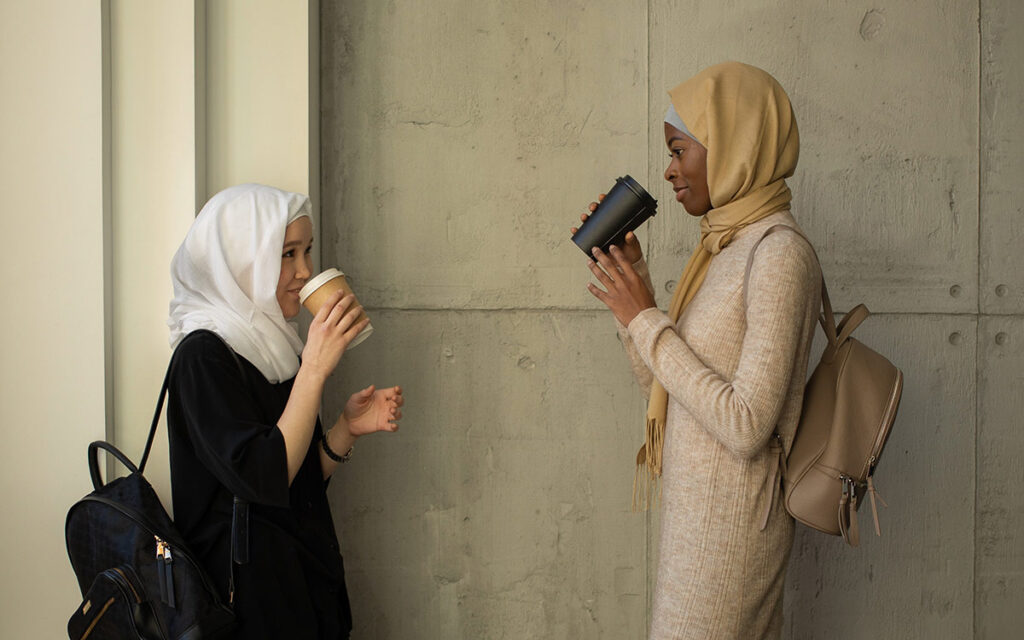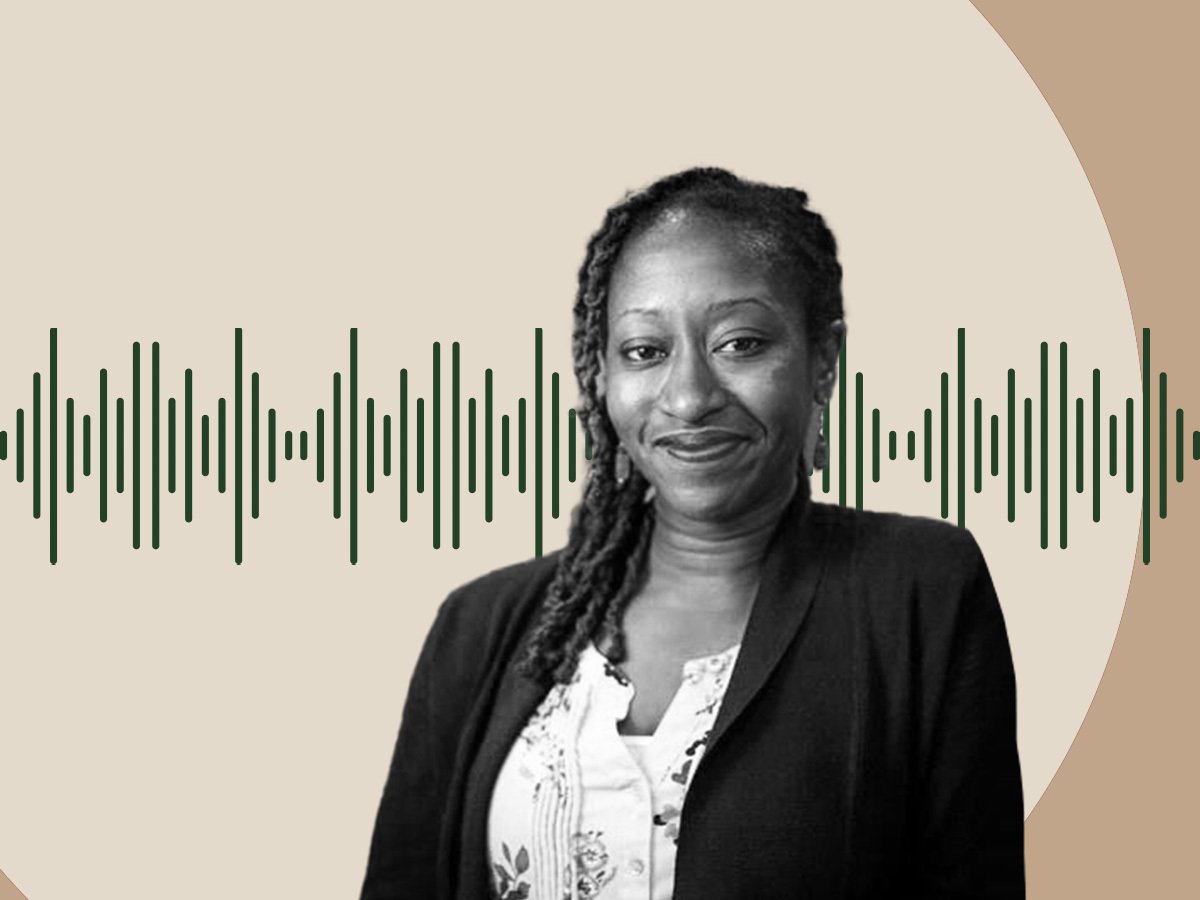
Why is the international community so quick to pounce on the subject of “veiled” Muslim women’s bodies? For decades, Muslim women’s bodies and clothing—especially the burqa and hijab—have been the subject of intense media and political scrutiny. Images and feature stories perpetuated by news outlets worldwide impact how Muslim women’s identities are perceived, by themselves and others, influencing their lives and social roles—and global politics.
For decades, Muslim women’s bodies and clothing—especially the burqa and hijab—have been the subject of intense media and political scrutiny.
On September 16, 2022, Mahsa Amini, a 22-year-old Kurdish woman in Iran, died while in police custody for allegedly wearing an “improper hijab.” Her death sparked countrywide protests challenging Iran’s repressive regime. Global protests followed within days. At the protests, Iranian women burned their hijabs and cut their hair to challenge the imposition that led to Amini and other women losing their lives. The state’s violent response to these protests led to social media solidarity campaigns from women around the world and weeks of media attention focused on the hijab’s role in Muslim women’s lives.
Since Iran’s protests started, international media has reported thousands of arrests and hundreds of protester deaths at the hands of police. Iran’s protests have since taken various forms online and on the ground—and six months on, they continue amid Iran’s unsuccessful attempts to suppress them. Global media opinions have accompanied these crackdowns, with each intervention and take more heated than the last.
Countering the Negative Narratives
While the last few months of protest have been nothing short of revolutionary in Iran, let’s be clear. What’s groundbreaking isn’t protesters’ fight against the hijab—it’s their unflinching, active struggle against national and global powers for their freedom. Yet, this garment has long been discussed in relation to Muslim women’s lives, and it continues to be the focus of mainstream reporting on the protests. Countering these predominantly negative images and narratives requires an active effort to track how they are normalized in political decisions and media coverage.
This focus on religious garb as a symbol of women’s oppression obscures the social and political context behind the protests.
Mobashra Tazamal, an academic researcher on Islamophobia, points out that hijab-centric media coverage limits a full understanding of Iran’s uprisings—particularly for those outside the country. Often, it also perpetuates Islamophobia through simplistic interpretations of the hijab as oppressive. The New Yorker described the movement as “Iran’s Hijab Protest Movement,” for example, even as the featured interview discusses the movement’s long history, including key popular demands like the right to vote.
“Western media coverage has largely been focused on hijab and the veiling laws. This [movement] is about the hijab and not about the hijab at the same time. In the context of Iran, the government is using hijab as a tool—it’s not [about] the hijab but the way government is using it. But Western media is simplifying it, so the hijab has come to represent everything,” she says.
This focus on religious garb as a symbol of women’s oppression obscures the social and political context behind the protests. Increasing fuel prices, crackdowns on reformist media, and discrimination against women being appointed in certain leadership and judicial positions are just some of the grievances that came to a head in these protests.
As Iranian scholar Fatemeh Shams, who has lived in exile since 2009, told The New Yorker, “Four decades of the economic grievances, the treatment of ethnic and religious minorities, the discrimination against women, and then the body of this twenty-two-year-old Kurdish woman suddenly becomes the symbol of all of these layers of oppression.” So, while the hijab may be the symbol, pinning the whole movement on that symbol alone risks oversimplifying a struggle undertaken by multiple generations.
Tazamal says it’s more important to look at how Muslim women and their bodies are situated within global discussions to push a Western agenda in which countries like the US and UK are Muslim women’s saviors. Examples where women are forced to wear or forced to take off their hijabs stem from the same system of control.
However, any time Muslim women’s voices differ from the views of the popular White feminist movements that dominate gender justice arenas—or when Islamophobia impacts Muslim women in particular—popular media silences their voices.
Global Geopolitics and Ways of Control
This silencing happens in South Asia, too. In India, Muslims—and Muslim women specifically—face discrimination and violence under the country’s right-wing Hindu nationalist BJP regime. Last month, the Indian government banned a documentary that was critical of Prime Minister Narendra Modi and his role in the 2002 Gujarat pogroms where over 1,000 people died, calling it a “propaganda piece.”
While violence against Muslims in India wasn’t new in 2002, it has increased since. Activist Afreen Fatima told Al Jazeera that authorities bulldozed her home—and though she isn’t the only Muslim woman affected by this, global media outlets haven’t provided a platform to other women like her to tell their stories. The same lens that features Iranian and Afghan activists is hardly awarded to these Indian Muslim women. Why?
In short, Indian Muslims don’t fit the mold that powerful global media are trying to sell. In this case, they can’t fall back on the same tired narrative of Muslim men oppressing Muslim women. India’s strong political and economic ties with countries like the US and UK also hinder a critique of the country’s wrongdoings. “The singular narrative that has preoccupied Western countries until now does not even acknowledge the presence of Muslim women who are actually being oppressed by an Islamophobic government that infantilizes their views and dehumanizes them,” says Sara Ather, an architect and writer in India. “India’s 204 million Muslims remain uniquely invisible to the world, despite [the country] increasingly becoming one of the most hostile places for minorities.”
Sign up for our free newsletters
Subscribe to NPQ's newsletters to have our top stories delivered directly to your inbox.
By signing up, you agree to our privacy policy and terms of use, and to receive messages from NPQ and our partners.
Ather notes that Indian Muslim women have been subjected to extreme forms of humiliation beyond just the hijab ban that has gained some recent media attention. Some examples include the creation of platforms like Sulli Deals and Bulli Bai to virtually auction off Muslim women in India. On the platform, pictures of Muslim women were uploaded so users could “bid” on them while talking about how they’d use them—as if they were objects. India has yet to face the international sanctions or threats that countries like Afghanistan or Iran do, and its political alliance with the US and other global powers has only emboldened its government to get away with human rights abuses.
These comparisons may seem different, but they share more similarities than most people realize. Not only because they stem from the same desire to control vulnerable groups but because of how global geopolitics shapes national and local politics. This is why US- and UK-based media discourses about Muslim women are important.
“We all have our biases—journalists included, and I think these biases always come out in some way or another,” says Hafsa Lodi, a journalist and author of Modesty: A Fashion Paradox. “So I think it’s difficult for any media coverage to ever fully, ‘accurately’ cover political issues surrounding Muslim women, as every discussion about Muslim women has become so inextricably political.”
The Issues with Savior Narratives
The relationship between Muslim women, their own bodies, and their faith has become a political tug-of-war, with those on either end tugging on a Muslim woman’s body to make her actions mean what they want. As a result, Muslim women’s bodies are loaded with excessive political meaning, with commentators interpreting every action as signaling a new social and political stance. “In media, Muslim women are oppressed or hypersexualized. Campaigns to ‘de-veil’ Muslim women, turning them into exotic sexual beings, hurts [their] quest for these rights because they’re not centering them, they’re centering the Western media’s own narratives,” says Tazamal.
These political positionings of Muslim women’s bodies and existence have been used to justify invasions, interference, and actively Islamophobic approaches to Muslim women and Muslim communities living in non-Muslim countries. “For so long, Western governments have tried to give Westerners this feeling that they are so much better than the rest of the world and they [the Muslim world] need the West and the only reason [for] going to war is to save them,” says author and Islamic law scholar Fatima Barakatulla, who is also the director of UK-based nonprofit organization, Muslim Womanhood.
Such attempts to position Muslim women aren’t always actively malicious—even when their consequences are. Many journalists and leaders who see themselves as wanting to “help” Muslim women fall prey to a savior complex fed by decades of skewed media discourse. When the US left Afghanistan amidst a Taliban takeover, there were well-founded concerns for women’s safety. But when those concerns turned into a desire to go back and help Afghan women—a help that civil society had not been able to provide in 20 years of occupation, simply because they never bothered to uplift and listen to local voices—is when that Western savior complex became problematic. The constant imposition of a narrative that Muslim women must be saved denies the work of homegrown women’s rights movements in Afghanistan.
But silencing Muslim women or speaking for them is not the way to create change—and in fact, does more harm than good. “I think that White savior narratives certainly ‘pick and choose’ details to campaign for, when it comes to situations and movements like the current one underway in Iran. I think that this can be incredibly harmful and has been in the past—such as the American incentive to invade Afghanistan, to ‘liberate’ local women of their burqas,” says Lodi.
On both sides of the spectrum—whether it’s extremist Islamist ideology or Western savior mindsets, Muslim women are considered weak and silent tools. But these women are not weak.
Those who venture to take a stand on dress codes, for example, must be principled about it. Lodi says, “In the case of Iran, I think that many Western White people genuinely wish to campaign for the freedom and autonomy of Iranian women. In this case, that looks like helping them topple an authoritarian regime that exerts patriarchal control over their dress codes. These same White saviors, however, should be equally outraged when France bans burkinis.” Her comparison is important for acknowledging the contradiction inherent in some (mostly White) women’s desire to show solidarity with women across the world. But their lack of understanding from a racially biased perspective makes these well-intentioned participants part of the same harmful narrative—one that presents Muslim women as helpless victims rather than agents.
“In these conversations within mainstream global media, the ‘West’ and the ruling authority in Muslim majority countries very much amplify each other because they shape their existence as existing opposite each other. So, when we look at the ‘West’ and ‘Islam,’ [it’s important to understand that] they are these binaries that don’t really exist, rather both end up regulating how Muslim women appear in public,” says Tazamal.
On both sides of the spectrum—whether it’s extremist Islamist ideology or Western savior mindsets, Muslim women are considered weak and silent tools. But these women are not weak. They are up against powerful global systems and policies. Analyzing and understanding this is necessary for responsible journalism—and social and political change.
To do better, Ather suggests, the media must listen to Muslim women around the world. “Acknowledge that Muslim women are not a homogenous block, that their political demands are different according to their geopolitical situation. Instead of applying a simplistic ideological lens to their situation, it’s best to listen to their voices and let them take on the narrative.”












